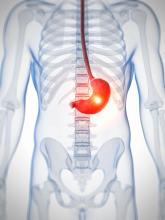Most malignancies with new ulcer were identified on initial gastroscopy in a retrospective cohort study, but it’s still worth performing follow-up procedures, according to investigators.
“Although the additional yield of malignancy at follow-up gastroscopy is low at 2%, our data supports the current strategy of repeat endoscopic assessment given variables in obtaining adequate ulcer histology and the lack of reliable endoscopic predictors of a malignant ulcer,” the study’s authors Linda Yang, MBBS, of the University of Melbourne, and colleagues wrote in the Journal of Clinical Gastroenterology.
Recommendations from the British Society of Gastroenterology emphasize the importance of repeat gastroscopy and biopsy of gastric ulcers within an 8-week period of the index gastroscopy. Additionally, the American Society of Gastrointestinal Endoscopy similarly recommends repeat gastroscopy in high-risk patients (ulcers >2 cm) within a 12-week period of the initial endoscopy. The authors noted that, despite these recommendations, there is a lack of consensus regarding timing of repeat gastroscopy, and no established ulcer biopsy protocols exist. Additionally, there is a lack of data on real-world repeat gastroscopy practices and follow-up outcomes.
To understand the current practice in gastric ulcer follow-up, Dr. Yang and researchers retrospectively examined new gastric ulcers diagnosed on gastroscopy between 2013 and 2017 at two separate Australian institutions.
Out of 795 patients (median age, 69 years; 59% male), approximately 55% (n = 440) underwent repeat gastroscopy at a median of 8 weeks after the initial endoscopy procedure. Overall, 52 patients (7%) received a malignancy diagnosis, with 83% (n = 43) of these diagnoses detected at the index gastroscopy; 2% overall received the diagnosis based on follow-up gastroscopy.
“I think these numbers would support the assumptions of most endoscopists that a small but still significant portion of new gastric ulcers will turn out to be malignant,” explained Michael DeSimone, MD, gastroenterologist at Emerson Hospital in Concord, Mass. Dr. DeSimone, who wasn’t involved in the study, said the data support the importance of “biopsy in the initial exam and bringing these patients back for a repeat endoscopy to check healing and biopsy unless malignancy was confirmed on the initial exam.”
In the study, a multivariate analysis revealed several predictors of benign ulcers, including lack of endoscopic suspicion at the index gastroscopy (odds ratio, 0.1; 95% confidence interval, 0.03-0.13; P ≤ .005), complete healing on repeat gastroscopy (OR, 0.5; 95% CI, 0.34-0.70; P = .036), and benign histology on initial biopsy (OR, 0.12; 95% CI, 0.43-0.90; P ≤ .005). However, no patient-related factors – such as H. pylori status and ethnicity – were associated with an increased likelihood of malignancy.
“Knowing that low suspicion for malignancy on initial exam and benign histology on initial biopsies predict benign ulcers ... reasonable endoscopists could feel more comfortable not repeating an exam where procedure safety is a significant concern if their suspicion was low on the index exam, especially if they had the opportunity to take initial biopsies and those ultimately show benign histology,” said Dr. DeSimone.
The investigators noted that the main reason behind 45% receiving no follow-up gastroscopy is that the ulcers had nonsuspicious appearance.
“Although not recommended, this is widely accepted clinical practice, especially in comorbid or elderly patients where the decision to undergo repeat gastroscopy requires consideration of their comorbidities, frailty, and life expectancy,” they wrote. They suggested that this, combined with high nonattendence rate in the cohort, emphasize the importance of ulcer biopsy at index gastroscopy, even in the absence of suspicious features.
Clinicians in the current study performed random gastric biopsies in 27% (n = 218) of patients. Helicobacter pylori, a component frequently described in high-risk populations, was detected in 22% of patients who had an ulcer or gastric biopsy performed.
The relatively low frequency with which random gastric biopsies were performed during the index endoscopy to look for H. pylori is a bit surprising, said Linda Lee, MD, medical director of endoscopy at Brigham and Women’s Hospital in Boston, given the bacterium remains a common and readily treatable etiology of gastric ulcers. “While it is known that yield of biopsy can be lower for H. pylori in the setting of acute upper gastrointestinal bleeding, it is still important to evaluate for this especially since biopsies carry low risk for bleeding,” explained Dr. Lee, who also wasn’t part of the study.
She added said that the study’s high negative predictive value for endoscopic suspicion of malignancy (96%) is reassuring. “This, combined with benign histology on initial biopsies, could serve to identify which patients should return for repeat endoscopy.”
“We need to ensure that more biopsies are obtained during the index endoscopy from gastric ulcers as well as randomly and that, during follow-up endoscopy, biopsies are obtained from all [partially or fully] nonhealed ulcers,” added Dr. Lee. She suggested it could be helpful to develop an evidence-based, prospectively validated algorithm and/or identify risk factors that reliably help endoscopists decide who would benefit from repeat endoscopy, “especially since there is a relatively high rate of noncompliance with a low rate of malignancy.”
A primary limitation of the study included its retrospective nature; however, the authors pointed out that the study currently represents the largest multicenter, retrospective cohort analysis of endoscopic follow-up for gastric ulcers.
“Before any change can be recommended to current clinical practice, prospective and potentially randomized studies are required to validate our findings and elucidate any high-risk features associated with malignant gastric ulcer,” the investigators wrote. Doing so could lead to reductions in health care cost and patient burden.
Some of the study authors received funding from the National Health and Medical Research Council of Australia, but the remaining authors declared having nothing to disclose. Dr. DeSimone and Dr Lee reported having no relevant conflicts.

